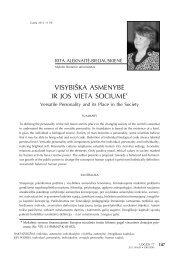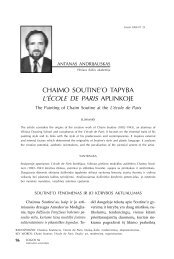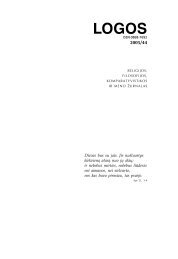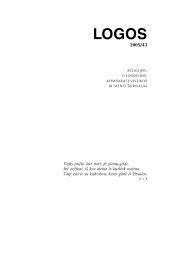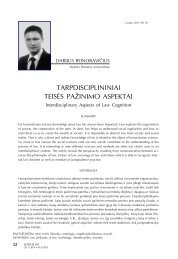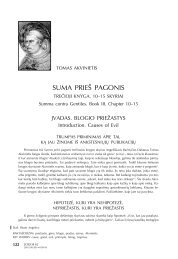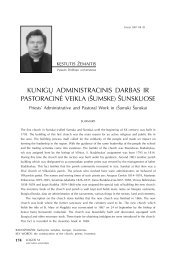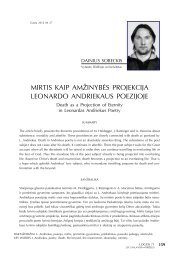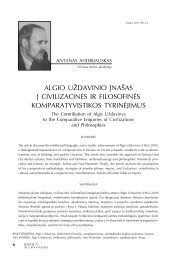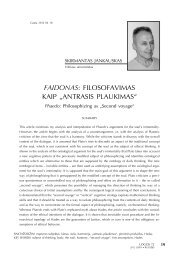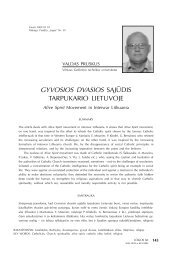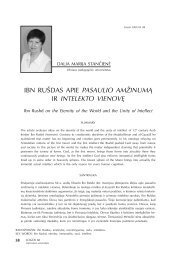Bet kvailas žmogus įgis supratimą, Kai laukinė a - Logos
Bet kvailas žmogus įgis supratimą, Kai laukinė a - Logos
Bet kvailas žmogus įgis supratimą, Kai laukinė a - Logos
You also want an ePaper? Increase the reach of your titles
YUMPU automatically turns print PDFs into web optimized ePapers that Google loves.
SALOMËJA JASTRUMSKYTË<br />
ir iðraiðkingumas. Daugiausia dëmesio<br />
dailininkë skiria plastinëms problemoms<br />
– spalva, forma, ritminës struktûros,<br />
sudëtingi erdviniai santykiai, deformacijos<br />
natûraliai susipina jos kûriniuose.<br />
Aptariamas ciklas liudija, kad<br />
dailininkë áþengia á kokybiðkai naujà savo<br />
dvasinës evoliucijos etapà, kuriame<br />
178 LOGOS 42<br />
2005 BALANDIS • BIRÞELIS<br />
pilna jëga atsiskleidþia jos meninio màstymo<br />
subtilumas.<br />
Labai norisi tikëti, kad ði jauna ir neabejotinai<br />
talentinga naujosios kartos<br />
menininkë, apèiuopusi savo plastinës<br />
raiðkos sritis, nepraras dvasiniø polëkiø<br />
ðvieþumo ir sëkmingai naudos savo kûrybiná<br />
potencialà.<br />
The Symbols of Salomëja Jastrumskytë’s<br />
Subconsciousness<br />
The majority of Salomëja Jastrumskytë‘s<br />
artworks seem like metaphysical<br />
poetry translated into the language<br />
of plastic visions. It is possible to<br />
speak about two tendencies in her art:<br />
metaphysical and decorative. The origins<br />
of the first are related to the Romantic,<br />
Symbolist and Surrealist art, and those<br />
of the second are close to the aesthetic<br />
sterility of Japanese decorative art and<br />
the poetry of Surrealist composition.<br />
These two tendencies are conjoined by<br />
periodic and spontaneous discharges of<br />
energy, expressed by the emotional language<br />
of dynamic lines. Perhaps it is<br />
possible to maintain that in recent years<br />
in her creative work the second tendency<br />
has prevailed. That is a sign that she<br />
heightens the formal demands on her<br />
own works.<br />
Salomëja belongs to a type of creator<br />
who are extremely sensitive to the<br />
sounds, colours and forms of the external<br />
world: who absorb them into their<br />
Prof. Antanas Andrijauskas<br />
own consciousness, transform and express<br />
by the artistic language of condensed<br />
images and symbols. Although<br />
in her artworks the traits of medieval<br />
religious ecstasy, romantic universality,<br />
poetic surrealism, metaphysical and abstract<br />
painting, and Far East calligraphy<br />
are present, nevertheless she is not subdued<br />
by traditional standards, and<br />
looks for her own original way.<br />
The deep philosophical subtext, subtle<br />
style, elaborated composition, and<br />
richness of colours are characteristic of<br />
her artworks, which embrace the expressive<br />
techniques of Medieval, Romantic,<br />
Surrealist, Abstract, and Eastern<br />
art. Most probably the origins of her<br />
creativity lie in her subconsciousness, in<br />
memories of early childhood, and in the<br />
fictional vision of the museum.<br />
It is credible that this talented young<br />
artist will not lose the drive and freshness<br />
of her spiritual flights and will successfully<br />
continue her artistic activity.<br />
Prof. Antanas Andrijauskas



